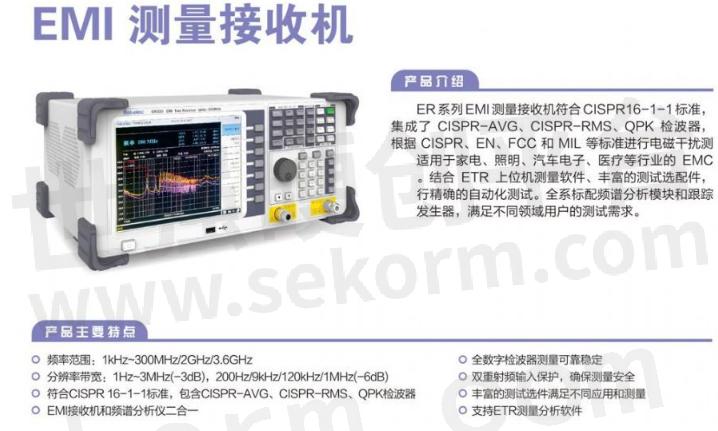EMI Measurement of the Working Principle and Product Advantage of the Receiving Machine

EMI refers to electromagnetic interference, which refers to the interference caused by electromagnetic waves generated by various electronic equipment during the work process. To avoid electromagnetic interference, EMI tests are required to ensure that it meets international standards. The EMI test receiver is one of the important equipment for EMI testing, which is used to measure the transmission and reception of electromagnetic waves in the device.
The principle of EMI testing the receiver receives the electromagnetic wave signal generated by the device to be tested through an antenna, converts the signal into an electrical signal within the frequency range, and then converts it to readable digital signals or sound signals through a specific processing circuit. To determine whether the equipment to be tested meets the requirements of electromagnetic compatibility.

The product advantage of the EMI measurement receiver includes:
High Sensitivity: The EMI measurement receiver can detect a weak electromagnetic interference signal, which may affect the normal operation of electronic devices.
Broadband: EMI measurement receiver can work within a wide range of frequency range, so the electromagnetic interference signals in different frequencies can be detected.
Strong Tone: The EMI measurement receiver can adjust its sensitivity and frequency range to meet different test needs.
High-precision: EMI measurement receivers can provide accurate electromagnetic interference signal measurement results to help engineers perform accurate interference analysis.
Large Capacity: EMI measurement receivers can test multiple devices or systems at the same time, thereby improving test efficiency and production efficiency.
In short, the EMI measurement receiver is an indispensable and important tool in electronic equipment and system testing. It has the advantages of high precision, high sensitivity, strong adjustability, and large capacity. It can provide engineers with accurate interference analysis and solutions.

The EMI measurement of the EMI measurement of the Baluelec and produced by the EMI measurement of the CISPR-AVG, CISPR-RMS, QPK detectors are integrated with CISPR16-1-1. , lighting, automotive electronics, medical and other industries. Combining ETR upper machine measurement software, rich testing options, and accurate automation testing. The entire system standards spectrum analysis module and tracking generator to meet the test needs of users in different fields.
Main Characteristics
Frequency range: 1kHz ~ 300MHz/2GHz/3.6GHz
Resolution bandwidth: 1Hz-3DB (-3DB), 200Hz/9kHz/120kHz/1MHz (-6DB)
Compliance with CISPR 16-1-1 standard, including CISPR-AVG, CISPR-RMS, QPK detector
EMI receiver and spectrum analyzer two-in-one
The whole digital detector measurement is reliable and stable
Dual RF input protection to ensure measurement safety
Rich test options meet different applications and measurement
Support ETR measurement analysis software
- +1 Like
- Add to Favorites
Recommend
- Baluelec Releases MSG200A Microwave Signal Source Module with the Frequency Range of 9kHz ~ 20GHz
- Baluelec Releases HRA4080 RF Comprehensive Tester Supporting Multi Touch Operation for Various Parameter Testing Needs
- How to Use the Spectrum Analyzer?
- Handheld Spectrum Analyzer Function
- The ST4000 Series Integrated Tester Can Be Selected from 9kHz ~ 1.8GHz to 9kHz ~ 6GHz
- What Is the Difference Between Vector Signal Source and Radio Frequency Signal Source?
- Precautions for Purchasing Signal Generators
- PSA080 Spectrum Analyzer Cover the Frequency Band from 5kHz to 8GHz and Has a Noise Level Better than -160dbm
This document is provided by Sekorm Platform for VIP exclusive service. The copyright is owned by Sekorm. Without authorization, any medias, websites or individual are not allowed to reprint. When authorizing the reprint, the link of www.sekorm.com must be indicated.






























































































































































































































































































































































































































































































































































































































































































































































































































































































